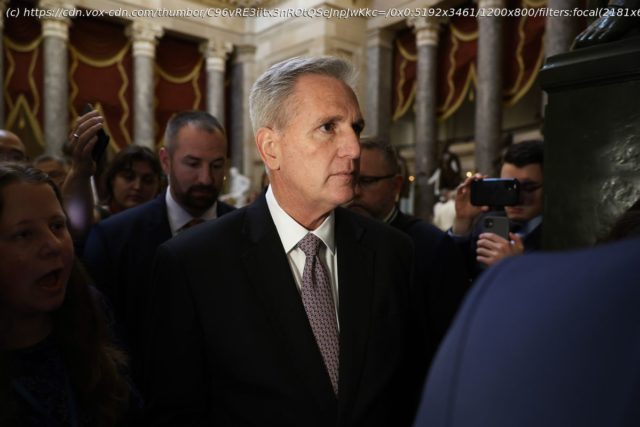Why Trump endorsed Jim Jordan, Steve Scalise’s speaker bid, what’s going to happen to Gaetz and McCarthy, and more.
Former President Donald Trump has endorsed Rep. Jim Jordan (R-OH), a conservative firebrand and the powerful chairman of the House Judiciary Committee, to be the next House speaker.
In a Friday post on his social media platform Truth Social, Trump said Jordan “is STRONG on Crime, Borders, our Military/Vets, & 2nd Amendment … He will be a GREAT Speaker of the House.”
Trump’s endorsement will likely help Jordan, but may not be enough to ensure he defeats his chief rival for the speaker position, Louisiana’s Rep. Steve Scalise, the Republican majority leader. At the moment, both appear to be struggling to capture the 218 votes needed to become the next speaker.
As each lawmaker works to solidify support, legislative business in the House has ground to a halt at a moment when lawmakers are staring down a fast-approaching November deadline to fund the government for the next year.
All this comes after House Republicans ousted Rep. Kevin McCarthy (R-CA) as speaker in an unprecedented vote, leaving them scrambling to pick a replacement who can unify a caucus that has recently struggled to agree on key legislative priorities.
The party’s more conservative and far-right members had long been a thorn in McCarthy’s side and finally brought about his downfall less than 10 months after he won a hard-fought contest for the speakership. Democrats refused to save McCarthy after he ruled out making concessions in exchange for their support.
The speakership drama has been yet another display of congressional dysfunction wrought by the GOP, just days after Republican hardliners prepared to shut down the government over a laundry list of unattainable demands. And it raises doubts about whether anyone can keep the Republican caucus in line enough to carry out the basic functions of the House — or if chaos will continue regardless of who’s in the speaker’s chair.
Here are your biggest questions about the fallout from McCarthy’s ousting and what could happen next, answered.1) How did McCarthy lose the speaker job?
Rep. Matt Gaetz (R-FL) led the charge to strip McCarthy of the speakership after he cut a deal with Democrats to fund the government for another 45 days — just before it would have otherwise shut down at the hands of right-wing rebels in the caucus. Gaetz brought a motion to vacate on the House floor, a procedural move that had never before been successfully used to oust a speaker.
This time, however, was different.
Although McCarthy had most of his caucus behind him, he needed a majority of the House to vote against his removal to stay in power. At the moment, the GOP has a four-vote majority, and on October 3, a total of eight Republicans joined all present Democrats in voting to depose McCarthy. Five of them — Reps. Andy Biggs (R-AZ), Ken Buck (R-CO), Eli Crane (R-AZ), Bob Good (R-VA), and Matt Rosendale (R-MT) — are members of the ultra-conservative House Freedom Caucus.
That was it for McCarthy.2) How did we get to the point where a motion to vacate was filed?
The key thing to know here is that McCarthy came in as a weak speaker who got the top job by making promises that would ultimately be difficult to keep — and concessions that would lead to his undoing.
His elevation to speaker took place after an excruciating four days and 15 ballots of voting this January — the messiest speaker election since 1860. During that process, he had the loyalty of most House Republicans but struggled to lock down support from about 20 right-wing holdouts. Eventually he got enough of them, in part by making various promises about how spending bills would be handled. He also agreed to a rule that lets any House member force a vote on his ouster at any time — handing his critics a powerful weapon, the “motion to vacate the chair.”
Then McCarthy had to actually govern the House in a time of divided party control of government. With Republicans unable to pass any laws on their own, the issues that inevitably rose to the top of the agenda were the “must-pass” measures Congress perpetually grapples with: the debt ceiling, and funding of the federal government. Many conservatives hate voting for both of these, and they especially hate any deal with Democrats struck over them. But actually breaching the debt ceiling or keeping the government shut down forever would be a disaster for the country and likely a political disaster for the GOP.
So McCarthy tried to convince the far right that he was driving as hard a bargain as he could with President Joe Biden and Senate Democrats on those matters. He kept his GOP conference united through the debt ceiling talks, eventually arriving at a pretty reasonable compromise in late May that lifted the debt ceiling.
But the government still had to be funded by September 30 or a shutdown would ensue. And that’s where things went off the rails. McCarthy could not fulfill the various promises he’d made about how spending bills would be handled, and couldn’t get many of the same GOP holdouts who wouldn’t support his speakership bid to back anything halfway realistic.
As the deadline approached, McCarthy made various attempts to unite Republicans around a negotiating strategy, all of which failed. He also threw some red meat to the base — for instance, by announcing last month that he was opening an impeachment inquiry into President Biden — which many viewed as an attempt to pacify the hard right before the inevitable ugly spending deal.
Gaetz sharply critiqued McCarthy’s efforts throughout the entire process, eventually saying he and his allies wouldn’t back any short-term deal that would keep the government open as full-year spending negotiations continued. With hours to go before a shutdown, McCarthy finally put up exactly the sort of stopgap bill Gaetz was against for a vote. It passed due to Democratic backing, averting a shutdown for 45 days.
After that, Gaetz struck, saying McCarthy had been a failed leader, and used the motion to vacate to force a vote on McCarthy’s ouster. 3) Why did some Republicans want McCarthy gone?
Most of the eight Republicans who voted to oust McCarthy cited the 45-day government funding bill, saying it was a symptom of his broader failure to secure big enough conservative wins and change the way things are done in Washington.
Many of McCarthy’s opponents want to see spending cuts that seem clearly unrealistic, and wanted to have extended debates on full-year spending bills there was simply no time for (unless these discussions were held while the government was shut down).
But some had other motivations. Gaetz, who led the charge, has reportedly blamed McCarthy for letting a congressional ethics investigation into him proceed. The Justice Department had investigated Gaetz over a purported sexual relationship with a 17-year-old, but the probe ended in no charges for him.
Home
United States
USA — Financial 9 questions about Kevin McCarthy’s downfall and House GOP chaos, answered






